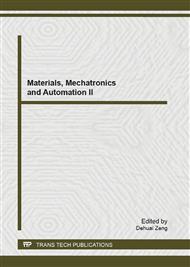p.3
p.9
p.14
p.27
p.39
p.45
p.51
p.56
Research on Adaptive Controlled High Building Slow-Down Rescue Apparatus
Abstract:
t firstly set up energy converting control model of high building rescue apparatus (HBRA), and developed a controller of the HBRA by using AVR micro computer unit (MCU), designed the control circuits for electric energy converting to thermal energy, then developed program to generate the PWM control wave. At last, it tested the PWM output wave of the controller, and experimented on the HBRA with the controller on loads of 15kg and 25kg. The results proves the controller can automatic adjust the duty ratio of PWM wave according to the different loads, which can keep the slow-down velocity constant of the loads and help people rescue from high buildings in emergency such as on fire.
Info:
Periodical:
Pages:
9-13
Citation:
Online since:
August 2013
Authors:
Keywords:
Price:
Сopyright:
© 2013 Trans Tech Publications Ltd. All Rights Reserved
Share:
Citation:


